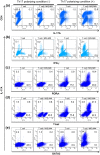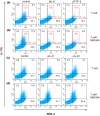Unique macrophages different from M1/M2 macrophages inhibit T cell mitogenesis while upregulating Th17 polarization
- PMID: 24553452
- PMCID: PMC3930092
- DOI: 10.1038/srep04146
Unique macrophages different from M1/M2 macrophages inhibit T cell mitogenesis while upregulating Th17 polarization
Abstract
Mycobacterial infection induces suppressor macrophages (MΦs), causing disease exacerbation. There are two major MΦ subsets (M1 and M2 MΦs) that are phenotypically and functionally different. Here, we examined which of the MΦ subsets the mycobacterial infection-induced suppressor MΦs (MIS-MΦs) belong to. MIS-MΦs down-regulated T cell production of Th1 and Th2 cytokines but markedly increased production of interleukin (IL)-17A and IL-22 through up-regulation of Th17 cell expansion. In this phenomenon, a novel MΦ population, which is functionally distinguishable from M1 and M2 MΦ subsets and possesses unique phenotypes (IL-12(+), IL-1β(high), IL-6(+), tumor necrosis factor (TNF)-α(+), nitric oxide synthase (NOS) 2(+), CCR7(high), IL-10(high), arginase (Arg)-1(-), mannose receptor (MR)(low), Ym1(high), Fizz(low), and CD163(high)), played central roles through the action of IL-6 and transforming growth factor (TGF)-β but not IL-21 and IL-23. This new type of MΦ population was induced in infected mice and actively supported the in vivo expansion of Th17 cells.
Figures






Similar articles
-
Spleen-derived macrophages are readily polarized into classically activated (M1) or alternatively activated (M2) states.Immunobiology. 2014 Oct;219(10):737-45. doi: 10.1016/j.imbio.2014.05.005. Epub 2014 Jun 6. Immunobiology. 2014. PMID: 24954891
-
Hepatitis C Virus-Induced Monocyte Differentiation Into Polarized M2 Macrophages Promotes Stellate Cell Activation via TGF-β.Cell Mol Gastroenterol Hepatol. 2016 Jan 8;2(3):302-316.e8. doi: 10.1016/j.jcmgh.2015.12.005. eCollection 2016 May. Cell Mol Gastroenterol Hepatol. 2016. PMID: 28090562 Free PMC article.
-
[Adipose-derived stem cells promote the polarization from M1 macrophages to M2 macrophages].Xi Bao Yu Fen Zi Mian Yi Xue Za Zhi. 2016 Mar;32(3):332-8. Xi Bao Yu Fen Zi Mian Yi Xue Za Zhi. 2016. PMID: 26927552 Chinese.
-
Regulation of Macrophage Polarization and Wound Healing.Adv Wound Care (New Rochelle). 2012 Feb;1(1):10-16. doi: 10.1089/wound.2011.0307. Adv Wound Care (New Rochelle). 2012. PMID: 24527272 Free PMC article. Review.
-
Pivotal roles of T-helper 17-related cytokines, IL-17, IL-22, and IL-23, in inflammatory diseases.Clin Dev Immunol. 2013;2013:968549. doi: 10.1155/2013/968549. Epub 2013 Jul 14. Clin Dev Immunol. 2013. PMID: 23956763 Free PMC article. Review.
Cited by
-
Piliation of Lactobacillus rhamnosus GG promotes adhesion, phagocytosis, and cytokine modulation in macrophages.Appl Environ Microbiol. 2015 Mar;81(6):2050-62. doi: 10.1128/AEM.03949-14. Epub 2015 Jan 9. Appl Environ Microbiol. 2015. PMID: 25576613 Free PMC article.
-
Holothurian triterpene glycoside cucumarioside A2-2 induces macrophages activation and polarization in cancer immunotherapy.Cancer Cell Int. 2023 Nov 24;23(1):292. doi: 10.1186/s12935-023-03141-z. Cancer Cell Int. 2023. PMID: 38001420 Free PMC article.
-
Defining the Balance between Regeneration and Pathological Ossification in Skeletal Muscle Following Traumatic Injury.Front Physiol. 2017 Apr 3;8:194. doi: 10.3389/fphys.2017.00194. eCollection 2017. Front Physiol. 2017. PMID: 28421001 Free PMC article. Review.
-
Wear particles induce a new macrophage phenotype with the potential to accelerate material corrosion within total hip replacement interfaces.Acta Biomater. 2020 Jan 1;101:586-597. doi: 10.1016/j.actbio.2019.10.039. Epub 2019 Oct 31. Acta Biomater. 2020. PMID: 31678260 Free PMC article.
-
Transcriptome Profiling of Bovine Macrophages Infected by Mycobacterium avium spp. paratuberculosis Depicts Foam Cell and Innate Immune Tolerance Phenotypes.Front Immunol. 2020 Jan 8;10:2874. doi: 10.3389/fimmu.2019.02874. eCollection 2019. Front Immunol. 2020. PMID: 31969876 Free PMC article.
References
-
- Benoit M., Desnues B. & Mege J. L. Macrophage polarization in bacterial infections. J. Immunol. 181, 3733–3739 (2008). - PubMed
Publication types
MeSH terms
Substances
LinkOut - more resources
Full Text Sources
Other Literature Sources
Research Materials
Miscellaneous

